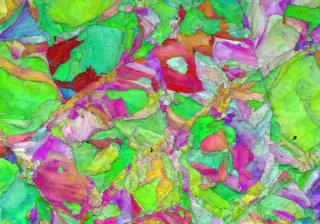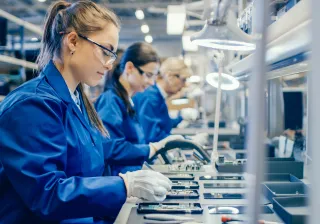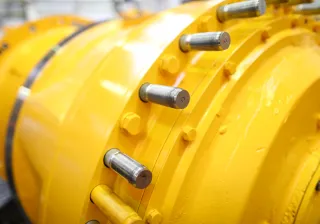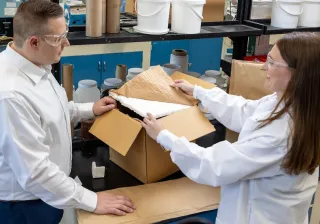VTT ProperTune for Wood helps us to understand how moisture changes the performance and durability of wooden structures. It gives guidelines on how to use wood properly and prolongs the service life of wooden buildings. The method suits equally well for optimising production conditions in the wood processing industry. VTT ProperTune for Wood is one of the spearhead projects in VTT´s DeepDigital approach. It combines the newest digital tools and numerical methods with industry-specific scientific expertise to create sustainable growth.
Wood is, by nature, a hydrophilic material. Therefore, designers must always estimate how moisture affects wooden buildings.
The task is not simple. Humidity and temperatures vary greatly in different climate zones, and wood-based materials like glued laminated timber (glulam) and cross-laminated timber (CLT) react differently to moisture.
To assist designers and constructors, the researchers of VTT have created VTT ProperTune for Wood; a structured toolset addressed to understand the effect of moisture on the safety, serviceability, durability, and the whole service life of wooden components in buildings.
"We combine digital methods with our deep scientific expertise. This combination makes our offering unique," says Jaakko Kuusisaari, the Customer Account Lead of the bio-based industry at VTT.
Virtual monitoring to replace physical sensors
VTT ProperTune for Wood consists of several science-based tools, databases, and models developed at VTT. It relies on the long experience in wood research at VTT, resulting in a large quantity of experimental data and many theoretical models that are nowadays used in the scientific community worldwide.
The input data for analysis contains among other things climate zone and weather data of the location, typology of wooden components used in the structure, and the wooden structure's dimensions.
"Based on the input data, we predict how the properties of the structure change due to moisture. We can see if there is a risk for cracking, deformation, or deterioration," says Petr Hradil, Senior Scientist at VTT.
The most significant advantage of VTT ProperTune for Wood is its ability to create a connection between complex hygro-thermal and mechanical relations and the real engineering structures and components.
"We can replace costly physical sensors with models and measure virtually. Sensors can be placed only in few locations. Models cover all locations and all variables," Kuusisaari says.
The models VTT ProperTune for Wood utilises are field-tested and validated.
"A lot of tools are developed in the wood research field. We focus on the computational side compared to the experimental side, which was done previously. Our models have a strong scientific background. We work in collaboration with many partners in Europe doing the indoor and outdoor experiments and test-based validations of our models", says Stefania Fortino, Senior Scientist at VTT.
Saving wood material without compromising service life
VTT ProperTune for Wood models are related to many applications where the effect of moisture is relevant. For instance, in engineering design, the dimensions of wood components are often limited by internal stresses and deformations caused by moisture.
"We can achieve savings by optimising the dimensions and thickness of wood components to achieve required service life," Fortino says.
In EU countries, the Eurocodes guide all construction. They are harmonised technical rules specifying how the structural design should be conducted within the European Union.
"Eurocodes are very conservative directives. Our method is not standardised, but we can calculate the actual need for wood material much more precisely than the Eurocodes do. We are at the level where we can save wood material in construction without compromising its performance," Hradil says.
Comparing coating methods is another promising way to use VTT ProperTune for Wood.
"To have a properly working wooden structure, wood should be protected properly. Structural wood is mainly sheltered from rain, but if the wood is in contact with water and moisture, the effect of different coating methods can be evaluated," Fortino says.
Maximize value from industrial processes
VTT ProperTune for Wood can be used also in the wood processing industry where moisture is an essential element.
"We can simulate the conditions where wood is processed. Then we can optimise the temperature and air pressures of the processes so that the wood or wooden components get the wanted properties," Hradil says.
One possible solution is optimising sawn timber´s drying conditions to speed up the wood drying process or achieve the wanted drying result with less energy.
The right answers to the vital questions
VTT ProperTune for Wood is often used in combination with other design tools. For instance, it can utilize information from the architectural design and provide inputs for the lifecycle assessment.
"The most common design tools concentrate on mechanical properties of wood, but don't know how the moisture affects. We can either optimize the parameters or connect different tools with a common interface," Hradil says.
VTT ProperTune for Wood projects are always answering the specific needs of the customers.
"We have means to create databases for specific needs and compare different methods. Our mathematical tools can be developed to simulate any process," Hradil says.
Mitigating climate change
In the coming decades, wood construction will have an essential role in mitigating climate change. Wooden buildings are globally large-scale carbon storages.
"If wood constructions are well designed, they are more durable than we think. With VTT ProperTune for Wood, we can make sure that wood is used properly in different locations and will have an appropriate coating. We can prolong the service life of wooden buildings and make sure that the wooden materials can be re-used when the buildings are no more needed," Hradil says.
VTT ProperTune for Wood also helps developing new products or building methods faster.
"We can replace heavy preservatives with more ecological solutions, or we can create all-new composite materials. It's possible to combine VTT ProperTune for Wood with VTT ProperTune©, which is developed to assist the design and production of new materials," Fortino plans.
The combined force of these two toolsets can produce more durable and lighter wood-based materials for building industry and many other purposes. These new recyclable materials play a central role in creating tomorrow’s circular economy.
“We truly want to create a large-scale impact together with our customers,” Kuusisaari says.
- Evaluation of deformations, cracks, and decay
- Prediction of service life
- Sensorless monitoring & IoT
- Evaluation of the moisture damage
- Effect of coating and surface treatment
- Reducing the need for experiment
- Optimization of sawn timber drying process











